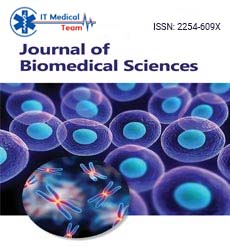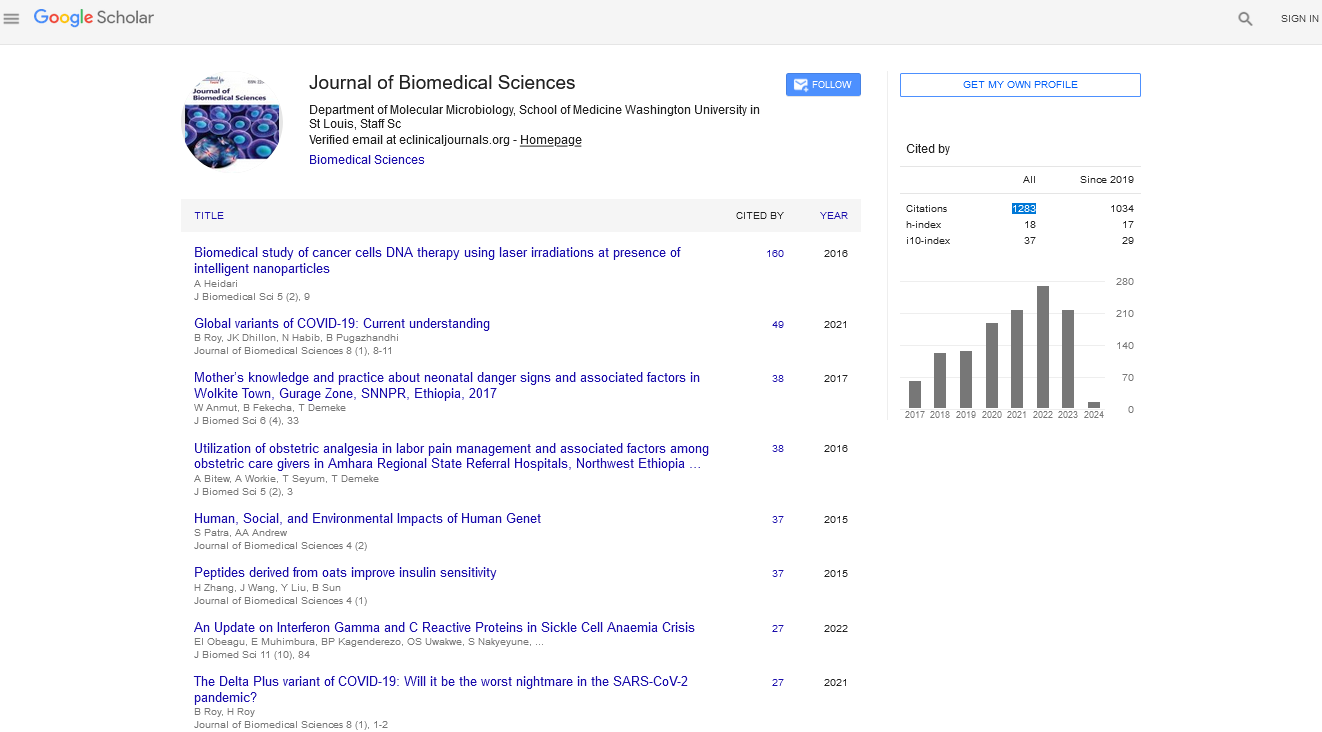Commentary - (2024) Volume 13, Issue 6
The Promise and Challenges of Gene Therapy in Treating Genetic Disorders
Kyle John Wilby*
Department of Biomedical Sciences, University of Otago, Christchurch, New Zealand
*Correspondence:
Kyle John Wilby, Department of Biomedical Sciences, University of Otago, Christchurch,
New Zealand,
Email:
Received: 19-Nov-2024, Manuscript No. IPJBS-24-15320;
Editor assigned: 22-Nov-2024, Pre QC No. IPJBS-24-15320 (PQ);
Reviewed: 06-Dec-2024, QC No. IPJBS-24-15320;
Revised: 17-Dec-2024, Manuscript No. IPJBS-24-15320 (R);
Published:
24-Dec-2024
Description
Gene therapy, an innovative field of medicine, offers the
promise of curing genetic disorders by directly modifying the
genes responsible for these conditions. By delivering therapeutic
genes into a patient's cells, scientists aim to correct or
compensate for defective genes, providing hope for patients
suffering from previously untreatable genetic diseases. Despite
its potential, gene therapy faces numerous challenges, including
ethical concerns, technical limitations, and regulatory hurdles.
This article explores the promise of gene therapy, its
applications, the challenges it faces, and the future of this
transformative approach in treating genetic disorders.
Understanding gene therapy
Gene therapy involves the introduction, removal, or alteration
of genetic material within a person's cells to treat or prevent
disease. The primary goal is to address the root cause of genetic
disorders by repairing or replacing faulty genes. Gene therapy
can be categorized into two main types: somatic and germline
therapy. Somatic therapy targets non-reproductive cells,
affecting only the individual treated, while germline therapy
involves changes to reproductive cells, which can be passed on
to future generations.
The mechanisms of gene therapy
Gene therapy can be implemented through various methods,
including:
Gene replacement: This involves introducing a functional
copy of a gene to compensate for a non-functional or missing
gene. Gene editing: Techniques like CRISPR-Cas9 allow for precise
modifications of the genome, enabling the correction of
mutations at specific sites. Gene silencing: This method aims to inhibit the expression of
a faulty gene that is contributing to a disease. Cell-based therapies: In some cases, patients’ cells are
modified outside the body before being reintroduced to the
patient, as seen in certain cancer therapies.
The promise of gene therapy
Potential cures for genetic disorders: One of the most
significant promises of gene therapy is its potential to cure
genetic disorders. Conditions such as cystic fibrosis, hemophilia,
muscular dystrophy, and certain inherited forms of blindness
have shown promising results in clinical trials. For example, the
FDA-approved gene therapy Zolgensma treats spinal muscular
atrophy by delivering a copy of the SMN1 gene, leading to
significant improvements in motor function for affected infants.
Personalized medicine: Gene therapy paves the way for
personalized medicine, allowing treatments to be tailored to the
individual’s genetic makeup. This personalized approach enhances
the efficacy of treatments, as therapies can be designed to target
specific mutations or genetic profiles, resulting in improved
patient outcomes.
Reduction in disease burden: By addressing the underlying
causes of genetic disorders, gene therapy has the potential to
significantly reduce the burden on healthcare systems. Successful
treatments could lead to improved quality of life for patients,
reduced healthcare costs associated with long-term management
of chronic genetic conditions, and decreased need for supportive
therapies.
Challenges facing gene therapy
Despite its promise, gene therapy faces several challenges
that must be addressed before it can become a mainstream
treatment option.
Technical limitations: While gene therapy has shown success
in clinical trials, translating these results into widespread clinical
applications is fraught with technical challenges.
• Delivery mechanisms: Effectively delivering therapeutic
genes to the right cells without causing adverse effects
is a significant hurdle. Current delivery methods, such as
viral vectors, can trigger immune responses or may not
efficiently target the desired cells.
• Durability of treatment: The longevity of gene therapy
effects is still uncertain. In some cases, the introduced genes
may not persist in the target cells over time, necessitating
repeat treatments.
Ethical concerns: The ethical implications of gene therapy,
particularly germline editing, raise significant concerns. Modifying
the genetic material of embryos can lead to unintended
consequences and ethical dilemmas regarding “designer babies”
and the potential for genetic inequality. As the technology
advances, discussions surrounding the ethical use of gene
therapy must evolve to ensure responsible application and
prevent misuse.
Regulatory hurdles: The regulatory landscape for gene
therapy is complex, as health authorities worldwide grapple with
establishing guidelines to ensure the safety and efficacy of these
novel treatments. The process of obtaining regulatory approval
can be lengthy and costly, creating barriers for researchers and
companies in bringing gene therapies to market.
High costs and accessibility: Gene therapy treatments can be
prohibitively expensive, limiting access for many patients. The
costs associated with research, development, and production of
gene therapies can result in treatments that are financially out
of reach for most individuals, raising concerns about health
equity and access to cutting-edge medical innovations.
Conclusion
Gene therapy represents a transformative approach to
treating genetic disorders, offering hope for patients and
families affected by these challenging conditions. While the
promise of gene therapy is immense, significant challenges
remain that must be addressed to ensure its successful
integration into clinical practice. Through ongoing research,
innovation, and ethical considerations, gene therapy has the
potential to revolutionize medicine, providing targeted and
effective treatments for a wide range of genetic disorders. As
the field continues to evolve, the journey of gene therapy from
the laboratory to the clinic will undoubtedly reshape the
landscape of healthcare and patient outcomes.
Citation: Wilby KJ (2024) The Promise and Challenges of Gene Therapy in Treating Genetic Disorders. J Biomed Sci Vol:13 No:6





